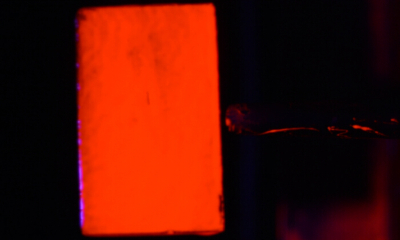Visualização de fluxo com corante de superfície: um método qualitativo para observar padrões de estrias em fluxo supersônico
Visão Geral
A visualização de fluxo ao redor ou em um corpo é uma ferramenta importante na pesquisa aerodinâmica. Fornece um método para estudar qualitativa e quantitativamente a estrutura de fluxo, e também ajuda os pesquisadores a teorizar e verificar o comportamento do fluxo de fluidos. A visualização do fluxo pode ser dividida em duas categorias: visualização fora da superfície e visualização do fluxo de superfície. As técnicas de visualização do fluxo fora da superfície envolvem determinar as características de fluxo ao redor do corpo de interesse. Eles incluem, mas não se restringem à velocimetria de imagem de partículas (PIV), imagem schlieren e visualização do fluxo de fumaça. Essas técnicas podem fornecer dados qualitativos e quantitativos sobre o fluxo ao redor de um corpo. No entanto, essas técnicas são geralmente caras e difíceis de configurar. As técnicas de visualização do fluxo de superfície, por outro lado, envolvem revestir o corpo de interesse com um corante para estudar o fluxo na superfície. Essas técnicas, que são mais invasivas na prática, incluem a visualização do fluxo de corante e, mais recentemente, o uso de tinta sensível à pressão, que dá uma imagem detalhada do fluxo na superfíciedocorpo. Isso permite que os pesquisadores visualizem diferentes características de fluxo, incluindo bolhas laminar, transições de camada de fronteira e separação de fluxo. A visualização do fluxo de corante, técnica de interesse no experimento atual, fornece uma imagem qualitativa do fluxo de superfície e é um dos métodos mais simples e econômicos de visualização do fluxo de superfície, especificamente para visualização de fluxos gasosos em um corpo.
Neste experimento, o comportamento do fluxo de superfície em seis corpos é estudado em fluxo supersônico. Os padrões de streakline são obtidos utilizando a técnica de visualização do fluxo de corante, e os caminhos de fluxo, grau de fixação e separação do fluxo, e localização e tipo de choques são identificados e estudados a partir das imagens de fluxo.
Procedimento
-
Observando linhas de listras no fluxo supersônico
- Misture o pó de corante fluorescente e o óleo mineral em uma tigela de plástico. Adicione pequenas quantidades de óleo mineral ao corante em incrementos, misturando-se continuamente até que uma mistura semi-viscosa seja obtida. A mistura não deve ser escorrendo.
- Monte a picada acima da câmara de teste do túnel de vento supersônico e bloqueie-a no lugar. Um túnel de vento supersônico com um 6 em x 4 na seção de teste e uma faixa de número mach operac
Resultados
Os padrões de fluxo streakline para os seis modelos e condições listados na Tabela 1 são mostrados abaixo. Para a cunha 2D, observa-se um padrão de fluxo uniforme sobre o corpo, como mostrado na Figura 4, exceto na região onde há uma deformidade superficial, o que faz com que o fluxo se separe. Quando angulado a 12°, o fluxo ao longo da superfície é desviado para cima. Este efeito é espelhado quando o modelo é angular a -12°. Em geral, todos os casos mostram...
Aplicação e Resumo
Padrões de fluxo de linha de streakline sobre seis corpos em fluxo supersônico foram estudados utilizando visualização de fluxo de corante superficial. Padrões de fluxo sobre as cunhas 2D e 3D mostraram que os efeitos da ponta desempenham um papel dominante na determinação da estrutura de fluxo de superfície. O fluxo sobre o cone mostrou-se totalmente ligado para uma faixa de deflexão de ±13°. O modelo de nariz contundente foi o primeiro corpo a mostrar uma linha de separação clara quando desviado em um âng...
Pular para...
Vídeos desta coleção:

Now Playing
Visualização de fluxo com corante de superfície: um método qualitativo para observar padrões de estrias em fluxo supersônico
Aeronautical Engineering
4.9K Visualizações

Desempenho Aerodinâmico de um Aeromodelo: O DC-6B
Aeronautical Engineering
8.3K Visualizações

Caracterização da hélice: variações no passo, diâmetro e número de pás no desempenho
Aeronautical Engineering
26.4K Visualizações

Comportamento do aerofólio: Distribuição de pressão sobre uma asa Clark Y-14
Aeronautical Engineering
21.1K Visualizações

Desempenho da asa Clark Y-14: Implantação de dispositivos de alta sustentação (Flaps e Slats)
Aeronautical Engineering
13.4K Visualizações

Método da esfera de turbulência: avaliando a qualidade do fluxo do túnel de vento
Aeronautical Engineering
8.7K Visualizações

Fluxo Cilíndrico Cruzado: Medição da Distribuição de Pressão e Estimando os Coeficientes de Arrasto
Aeronautical Engineering
16.2K Visualizações

Análise de bocais: variações no número de Mach e na pressão ao longo de um bocal convergente e convergente-divergente
Aeronautical Engineering
37.9K Visualizações

Imageamento de Schlieren: uma técnica para visualizar recursos de fluxo supersônico
Aeronautical Engineering
11.6K Visualizações

Visualização de fluxo em um túnel de água: observando o vórtice de ponta sobre uma asa delta
Aeronautical Engineering
8.1K Visualizações

Tubo Pitot-estático: um dispositivo para medir a velocidade do fluxo de ar
Aeronautical Engineering
49.0K Visualizações

Anemometria de temperatura constante: uma ferramenta para estudar o fluxo em camada limite turbulenta
Aeronautical Engineering
7.2K Visualizações

Transdutor de Pressão: Calibração Usando um Tubo Pitot-estático
Aeronautical Engineering
8.5K Visualizações

Controle de Voo em Tempo Real: Calibração de Sensor Incorporado e Aquisição de Dados
Aeronautical Engineering
10.3K Visualizações

Aerodinâmica de Multicópteros: Caracterizando o Empuxo em um Hexacóptero
Aeronautical Engineering
9.1K Visualizações
Copyright © 2025 MyJoVE Corporation. Todos os direitos reservados


